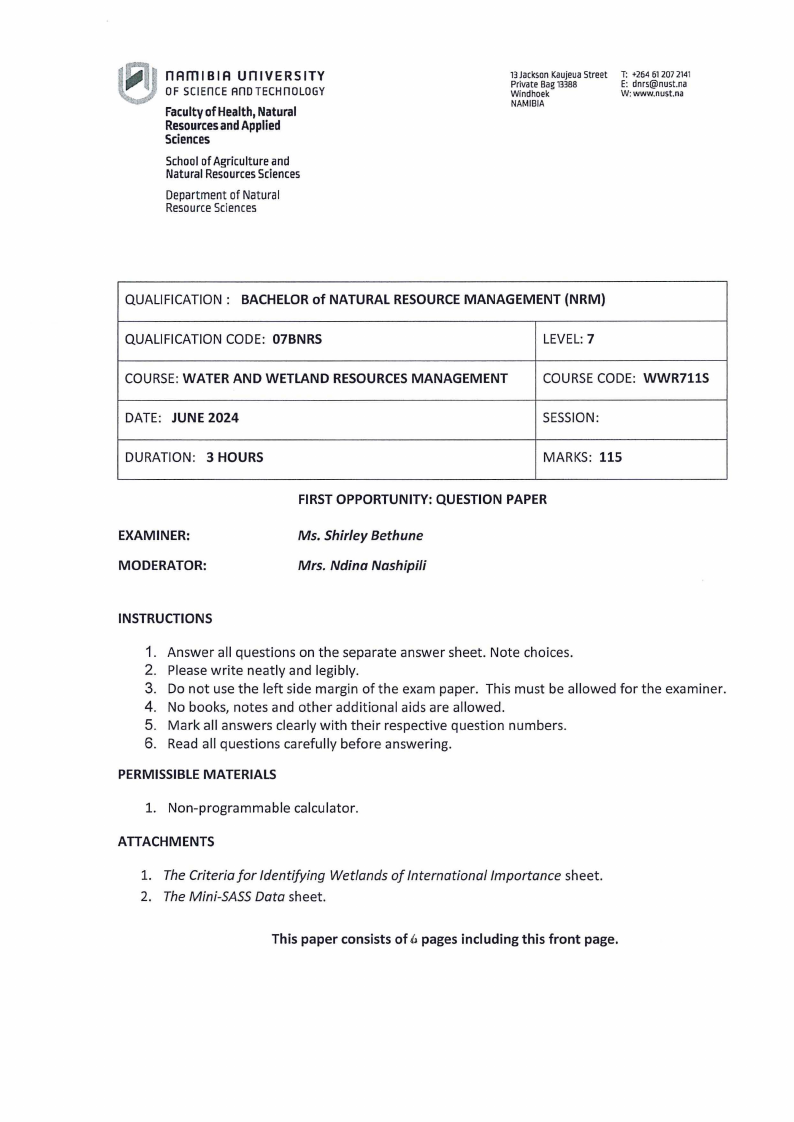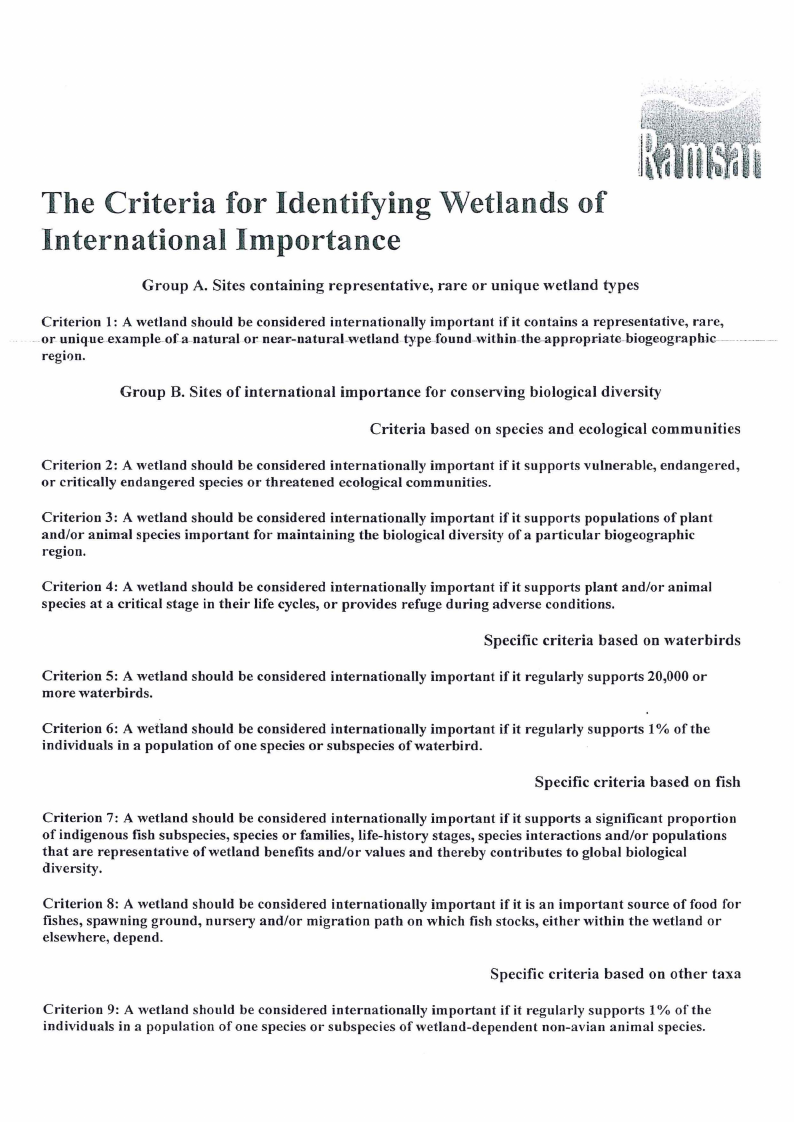 |
WWR711S-WATER AND WETLAND RESOURSES MANAGEMENT-1ST OPP- JUNE 2024 |
 |
1 Page 1 |
▲back to top |

'9 nAml BIA UnlVERSITY
OF SCIEnCE AnDTECHnOLOGY
FacultyofHealthN, atural
ResourceasndApplied
Sciences
Schoolof Agricultureand
NaturalResourcesSciences
Departmentof Natural
ResourceSciences
13JacksonKaujeuaStreet
Private Bag13388
Windhoek
NAMIBIA
T: +264 61207 2141
E: dnrs@nust.na
W: www.nust.na
QUALIFICATION: BACHELOR of NATURAL RESOURCEMANAGEMENT (NRM)
QUALIFICATION CODE: 07BNRS
COURSE:WATER AND WETLAND RESOURCESMANAGEMENT
DATE: JUNE 2024
DURATION: 3 HOURS
LEVEL:7
COURSECODE: WWR711S
SESSION:
MARKS: 115
EXAMINER:
MODERATOR:
FIRST OPPORTUNITY: QUESTION PAPER
Ms. Shirley Bethune
Mrs. Ndina Nashipili
INSTRUCTIONS
1. Answer all questions on the separate answer sheet. Note choices.
2. Please write neatly and legibly.
3. Do not use the left side margin of the exam paper. This must be allowed for the examiner.
4. No books, notes and other additional aids are allowed.
5. Mark all answers clearly with their respective question numbers.
6. Read all questions carefully before answering.
PERMISSIBLE MATERIALS
1. Non-programmable calculator.
ATTACHMENTS
1. The Criteria for Identifying Wetlands of International Importance sheet.
2. The Mini-SASS Data sheet.
This paper consists of 6 pages including this front page.
 |
2 Page 2 |
▲back to top |

WATER AND WETLAND RESOURCES MANAGEMENT WWR 711S
QUESTION 1. WETLAND MAP AND TERMINOLOGY
FIRST OPPORTUNITY QUESTION PAPER2024
1.1 Study the map below:
(12)
a) Name the two tributaries 1, and 2 of the Okavango River,
b) Name the river system 3,
c) Name the two dams and the rivers they are on 4 and 5,
d) Name the two endoreic rivers and the pan each ends at 6 and 7,
e) Name the pan system 8.
1.2 Give the correct term for:
(2)
a) A sandy riverbed that stores groundwater.
b) The artificial lake that forms behind a dam wall.
1.3 Clearly distinguish between:
(4)
a) Lotic and lentic wetlands.
b) Palustrine and lacustrine wetlands.
[18]
1
 |
3 Page 3 |
▲back to top |

QUESTION 2. RAMSAR CONVENTION
2.1 When is World Wetland Day Celebrated each year, what is the 2024 international theme and how (3)
did you experience this on our excursions to wetlands or on your own wetland survey?
2.2 Why is the International Convention on Wetlands known as the Ramsar Convention and give two (3)
activities that this convention encourages the countries that are members to do.
2.3 Choose either A or B
(8)
A Etosha Pan Ramsar Site
or
B Sandwich Harbour Ramsar Site
Use the attached Ramsar Criteria to draw up a table to motivate how and why the wetland you
choose meets four of the Ramsar Criteria. Draw up a table, briefly list each relevant criterion in
the first column and write your motivation in the second column
[14]
QUESTION 3. COASTAL WETLANDS
3.1 You are working as a tour guide in Luderitz and you want to tell your tour group about the
(7)
process that supports Namibia rich fishery. Explain the process of upwelling along our coast.
3.2 One of the tourists asks you if this is the same as a sulphur eruption. Explain to her how a
(5)
sulphur eruption is caused and the impact on the ocean and on the uranium mines at the coast.
[12]
QUESTION 4. RIVERINE WETLANDS - PERENNIAL, SEASONAL AND EPHEMERAL RIVERS
4.1 The parasitic disease, Urinary Bilharzia, is spreading from the Kunene River into the North
(8)
Central regions. You have been asked to prepare a poster for learners at Oshakati Combined
School to explain the life-cycle of this bilharzia parasite. Draw and clearly label your sketch.
4.2 The middle catchment or lishana section of the Cuvelai is unique within southern Africa, discuss (4)
the different kinds of wetlands found there and where and when these receive water.
4.3 Write a paragraph about the Namibian frog species that can survive its habitat drying out. Give (4)
the common and scientific names, say where they are found, how they survive the dry period,
what this process is called and conclude with their socio- economic value.
4.4 One important function of our ephemeral rivers is their function as biological corridors.
a) Explain what a biological corridor is and give the names of two large mammal species that use
(4)
ephemeral riverbeds as biological corridors in North-western Namibia.
b) As the Nature Conservator working in the Palmwag Concession area in North-western Namibia
(4)
you are concerned about the vehicles using the Hoanib riverbed as a road to get to the lodge.
Briefly discuss two conservation concerns that you want to raise about the vulnerability of the
wildlife that use this river as a biological corridor at the next conservancy meeting.
[24]
QUESTION 5. LACUSTRINE AND PALUSTRINE WETLANDS
5.1 Explain the meanings of cenote and hemi-cenote sinkholes and give a Namibian example of each. (4)
5.2 Name the endemic fish species found only in Aigamas Cave in the Otavi mountains.
(1)
5.3 Name and briefly discuss the different layers in a stratified impoundment in summer.
(6)
You may use a sketch to illustrate your answer.
2
 |
4 Page 4 |
▲back to top |

5.4 Based on what you have learnt about the frog that can survive in pools that dry out
(4)
a) Describe the wetlands where the endemic Nothobranchius capriviensis occurs,
b) Give its common name,
c) Name the conservancy where it is found.
d) Say why its conservation status should be upgraded by the IUCN to "Endangered".
5.5 Name two geothermal springs found in Namibia and explain where the water originates.
(2)
[17]
QUESTION 6. WATER AND WETLAND MONITORING
6.1 As you saw at Hardap Dam on our short excursion the amount of water stored in Hardap Dam is
now only 11% and normally seepage from the dam, allow the first section of the Fish River, below
the dam wall to be perennial.
The biology teacher at Mariental High School thinks that this lack of flowing water might have a
negative effect on the river health below the dam.
Recommend a suitable biomonitoring method the teacher can use with her Grade 10s and say
why it is suitable. Carefully explain how it works, and what equipment you need. Explain how his
learners should conduct this practical biomonitoring method, and how they need to record and
work out what their results mean using the set of tables you have been given.
6.2 Briefly explain why SASSand Mini-SASS methods only works in flowing rivers.
(1)
[15]
QUESTION 7. RIVER BASIN MANAGEMENT AND INTEGRATED WATER RESOURCESMANAGEMENT
7.1 Name the three riparian countries that share the Okavango River Basin
(3)
7.2 Explain what the Basin Wide Forum of the Okavango River was and how many representatives
(3)
each of the three riparian countries had.
7.3 Give the abbreviations and full names of the national committee and international
(4)
commission responsible for Okavango River.
7.4 ANSWER EITHER A ORB
A IWRM links upstream and downstream sections of a river system. Currently there is world-wide (5)
concern that activities upstream in Angola and Namibia can threaten the integrity or health of the
Okavango Delta in Botswana. Write a paragraph to discuss one, current, major activity in each
the Angolan and Namibian sections of the Okavango River Basin that is likely to reduce flow into
the Okavango Delta. Conclude with the main impacts that reduced water flows will have on the
Delta.
OR
B IWRM links habitats within a river basin, discuss how the efundja creates a wetland habitat in
Etosha and the life that it periodically supports there.
[15]
TOTAL 115
3
 |
5 Page 5 |
▲back to top |

Mini-SASS Data sheet
SITEINFORMATION TABLE
River name:
Date (dd/mm/yr):
Site name:
Collector's name:
GPSco-ord Lat(S):
Long(E):
School/organisation:
Site description:
,,.. , ,! .<l' i j·
Notes:
I'
'
pH:
oc Water temp:
Dissolved oxygen:
mg/I Water clarity: inr•>,JI \\,'\\•A·,,.111i!1i~,1•,•:..v1,~
Ecological category (Condition)
NATURAL CONDITION
(Uncham!ed/untouched- Blue)
GOOD CONDITION
(Few modifications - Green)
IF~Rm~omorn
(Some modifications - Orange)
POOR CONDITION
(Lots of modifications - Red)
VERYPOORCONDITION
(Critically modified - Purple}
RiverCategory
SandyType RockyType
>6.9
> 7.2
S.9to 6.8
6.2 to 7.2
S.4to5.8
5.7 to 6.1
4.8 to 5.3
5.3 to 5.6
< 4.8
<5.3
GROUPS
Flat worms
Worms
Leeches
Crabs or shrimps
Stoneflles
Minnow mayflies
Other mavflies
Damselflies
DraRonflies
Bues or beetles
Caddisflies (cased & uncased)
True flies
Snails
TOTAL SCORE
NUMBER OF GROUPS
AVERAGESCORE
jmlnlSASS Score)
SENSITIVITY
SCORE
3
2
2
6
17
s
11
4
6
5
9
2
4
 |
6 Page 6 |
▲back to top |

The Criteria for Identifying Wetlands of
International Importance
Group A. Sites containing representative, rare or unique wetland types
Criterion I: A wetland should be considered internationally important if it contains a representative, rare,
--Or-unique-example-of-a-natural-or near--natur:al-wetland-type-found-within-the-app r-0p~iate-biogeographic-- ---- --
regiQn.
Group B. Sites of international importance for conserving biological diversity
Criteria based on species and ecological communities
Criterion 2: A wetland should be considered internationally important if it supports vulnerable, endangered,
or critically endangered species or threatened ecological communities.
Criterion 3: A wetland should be considered internationally important if it supports populations of plant
and/or animal species important for maintaining the biological diversity of a particular biogeographic
region.
Criterion 4: A wetland should be considered internationally important if it supports plant and/or animal
species at a critical stage in their life cycles, or provides refuge during adverse conditions.
Specific criteria based on waterbirds
Criterion 5: A wetland should be considered internationally important if it regularly supports 20,000 or
more waterbirds.
Criterion 6: A wetland should be considered internationally important if it regularly supports I% of the
individuals in a population of one species or subspecies of waterbird.
Specific criteria based on fish
Criterion 7: A wetland should be considered internationally important if it supports a significant proportion
of indigenous fish subspecies, species or families, life-history stages, species interactions and/or populations
that are representative of wetland benefits and/or values and thereby contributes to global biological
diversity.
Criterion 8: A wetland should be considered internationally important if it is an important source of food for
fishes, spawning ground, nursery and/or migration path on which fish stocks, either within the wetland or
elsewhere, depend.
Specific criteria based on other taxa
Criterion 9: A wetland should be considered internationally important if it regularly supports I% of the
individuals in a population of one species or subspecies of wetland-dependent non-avian animal species.





